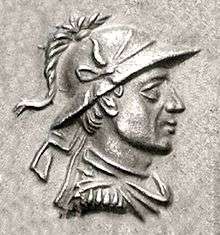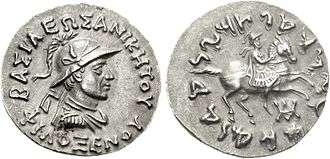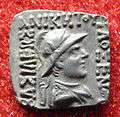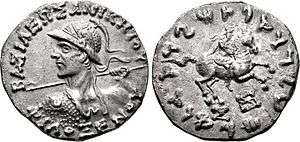Philoxenus Anicetus
Philoxenus Anicetus (Greek: Φιλόξενος ὁ Ἀνίκητος; epithet means "the Invincible") was an Indo-Greek king who ruled in the region spanning the Paropamisade to Punjab. Philoxenus seems to have been quite an important king who might briefly have ruled most of the Indo-Greek territory. Bopearachchi dates Philoxenus to c. 100–95 BCE and R. C. Senior to c. 125–110 BCE.
| Philoxenus | |
|---|---|
 Portrait of Philoxenus | |
| Indo-Greek king | |
| Reign | 100–95 BCE |
| Died | Mathura |

Obv: Helmetted, diademed and draped bust of Philoxenus. Greek legend ΒΑΣΙΛΕΩΣ ΑΝΙΚΗΤΟΥ ΦΙΛΟΞΕΝΟΥ "Of the Invincible King Philoxenus"
Rev: King on prancing horse in military dress. Kharoshti legend MAHARAJASA APADIHATASA PHILASINASA "Undefeatable King Philoxenus".
Historians have not yet connected Philoxenus with any dynasty, but he could have been the father of the princess Kalliope, who was married to the king Hermaeus.
Coins of Philoxenos
Philoxenus struck several series of bilingual Indian silver coins, with a reverse of a mounted king, a type previously used as obverse by Antimachus II sixty years earlier and as reverse on rare types of Nicias. Whether the horseman was a dynastic emblem or a portrait of the king as a cavalryman is unclear. Several Saka kings used similar horsemen on their coinage.
His drachms were square, another feature that was rare among Indo-Greeks but standard for Sakas, and this indicates that Philoxenus had connections with the nomads that had conquered Bactria.
Philoxenus struck bronzes with female deity/bull, or Helios/Nike.
Philoxenus also minted some Attic-type tetradrachms (with Greek legend only), meant for circulation in Bactria.
Other coins
- Philoxenus on horse.
 Philoxenus coin in the Indian square standard. Japan Currency Museum.
Philoxenus coin in the Indian square standard. Japan Currency Museum. Coin of Phyloxenos.
Coin of Phyloxenos.
See also
References
- The Greeks in Bactria and India, W. W. Tarn, Cambridge University Press.
External links
| Preceded by Antialcidas (in Paropamisade, Arachosia, Gandhara) |
Indo-Greek Ruler (in Paropamisadae, Arachosia, Gandhara, Punjab) 100 – 95 BC |
Succeeded by Diomedes (in Paropamisade) |
| Succeeded by Amyntas (in Arachosia, Gandhara) | ||
| Preceded by Demetrius III or Polyxenios (in Punjab) |
Succeeded by Epander (in Punjab) |
- O. Bopearachchi, "Monnaies gréco-bactriennes et indo-grecques, Catalogue raisonné", Bibliothèque Nationale, Paris, 1991, p.453
- Quintanilla, Sonya Rhie (2 April 2019). "History of Early Stone Sculpture at Mathura: Ca. 150 BCE - 100 CE". BRILL – via Google Books.
